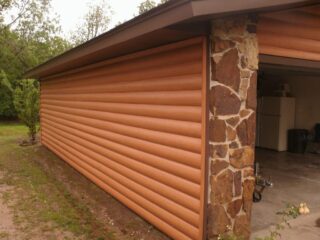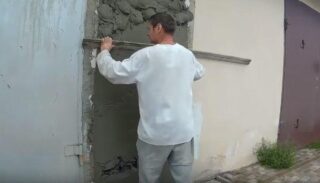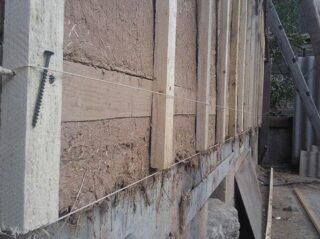The garage is an economic building. There is no need to maintain a comfortable temperature or provide difficult ventilation without losing heat. However, it is necessary to protect the building from rain, snow or sun. Finishing the garage facade significantly extends the service life.
The need for finishing the garage

The garage is built from materials of the maximum available: silicate or red brick, concrete, foam concrete, cinder blocks. However, the characteristics of building stone are very different and are intended for use only in certain climatic regions. This creates the need for protection.
The factors are as follows.
- Wall material - foam concrete, for example, has open pores. With high humidity and frequent rains, moisture penetrates and destroys the material. It must be protected from the action of water. The same applies to gas silicate blocks and expanded clay concrete.
- Increased strength - the garage box in the common area must be protected from the actions of hooligans.
- Aesthetics - a sloppy building next to a beautiful residential building looks unpresentable.
- Service life - if the facade, and the garage is not clad with clinker, which is a rarity, any finish - clapboard, profiled sheet, plaster - will extend its service life.
For covering the garage, they are trying to choose a relatively cheap option.
Exterior requirements

Materials for finishing the garage outside must meet the following conditions.
- Simplicity in installation or laying is still a farm building and it is unprofitable to spend a lot of time and effort on its facing.
- Water resistance - the main destructive factor is high humidity, as well as rain and snow. Therefore, for construction, it is better to choose materials that are insensitive to these factors, such as plastic siding or stone.
- Frost resistance is especially relevant for the northern regions. This requirement is met by low-porosity materials with a minimum expansion coefficient: clinker, steel siding.
- Aesthetics - even a farm building should look attractive - after all, this is a home for a car.
- Cost - Affordable materials are preferred.
If the garage is located next to the house or attached to it, which cladding to use is determined by the cladding of the facade of the building.
Types of materials

You can sheathe a private garage from the outside with a variety of materials. Many of them have additional qualities.
- Brick or stone is an expensive beautiful material that dishonors an excellent appearance. Clinker, facing brick, artificial stone for finishing has minimal porosity, frost-resistant, not afraid of water, snow, sun. Minus - complicated and expensive installation, high price. There is one more feature: the stone weighs a lot, such cladding creates a high load on the foundation and walls and must be incorporated into the project.
- Blockhouse - a variant of a wooden lining. Finishing has the same advantages as wood: environmentally friendly, beautiful, vapor permeable. However, she herself needs protection. The lining should be periodically painted, varnished or stained to increase its resistance to moisture. The peculiarity of the blockhouse is its shape. It imitates a log.
- Wooden lining is available in a variety of form factors. It can have a flat surface, imitate a bar, a log, and have a complex relief.The lining acts as a good heat and sound insulator, it is quite resistant to mold. However, any version of it needs care.
- Plaster is the cheapest way to finish with your own hands. The plaster is resistant to moisture, is able to prevent water from entering the wall material. Decorative plaster provides an attractive design. Its main drawback is fragility. Plastering has to be repeated once every 3-5 years.
- Siding outside the garage is the most common option. This is due to the variety of materials: they produce metal, plastic, wood, fiber cement siding. They have different properties and are suitable for different conditions.
- The plastic sheathing is resistant to water, does not lend itself to any kind of corrosion, but is sensitive to frost and not very durable. Metal siding is stronger, not afraid of moisture, sun, water, heat. However, it conducts heat and sound perfectly. Wooden wood is made from shavings and polymer resins, therefore it is much more resistant to moisture than natural wood. And fiber cement has all the advantages of the listed materials, but is heavier and creates a load on the wall.
- Sandwich panels are a finishing block that includes a chipboard or plywood base, a layer of insulation and a top layer - lining, siding, even clinker. Expensive material. They are sheathed if you want to insulate the garage.
It is possible to trim not only to protect the facade, but also to make it decorative. To do this, use, for example, the jointing of a brick wall. The work comes down to grouting the joints between the bricks with a lighter or darker contrasting paste. At the same time, the masonry seems more expressive, and the wall acquires a beautiful texture.
Finishing stages

Sheathing the garage with siding or clapboard outside is not so difficult. However, such work even without facade insulation takes time and effort.
- The walls are cleaned of dust and dirt, they get rid of the previous finish - paint or plaster.
- According to the size of the lamellas and the area of the facade, the parameters of the frame are calculated. Mark the attachment points on the wall.
- For the construction of the outer sheathing, a galvanized steel profile is used. Wood is allowed only as a last resort.
- Installation begins with the installation of the corner profile, starting and finishing planks. At the same stage, the door profile is assembled.
- The lamellas mature in length. The first element is snapped into the groove of the starting plate and fixed to the frame with self-tapping screws. The fasteners are not rigid.
- Each next lamella is inserted into the groove of the previous one and fastened. The last element is snapped into the lower one and inserted into the finishing strip.
Finishing the garage facade has different purposes: to protect the walls from rain and snow, to prevent wear and tear, to give the building an attractive look. In accordance with the requirements, the cladding material is also chosen.








